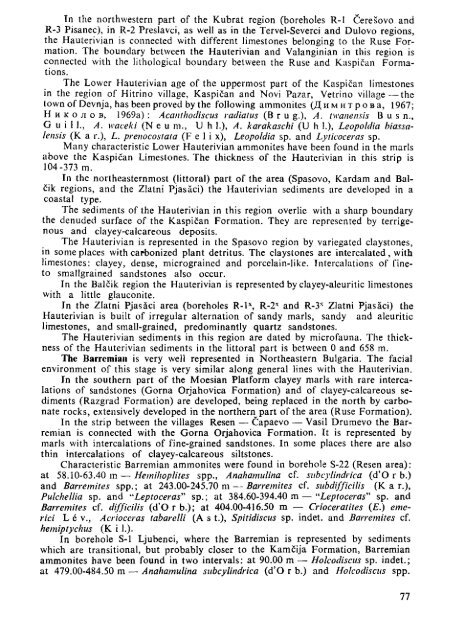THE MEDITERRANEAN LOWER CRETACEOUS
THE MEDITERRANEAN LOWER CRETACEOUS
THE MEDITERRANEAN LOWER CRETACEOUS
Create successful ePaper yourself
Turn your PDF publications into a flip-book with our unique Google optimized e-Paper software.
Tn the northwestern part of the Kubrat region (boreholes R-l Ceresovo and<br />
R-3 Pisanec), in R-2 Preslavci, as well as in the Tervel-Severci and Dulovo regions,<br />
the Hauterivian is connected with different limestones belonging to the Ruse Formation.<br />
The boundary between the Hauterivian and Valanginian in this region is<br />
connected with the lithological boundary between the Ruse and Kaspican<br />
tions.Forma<br />
The Lower Hauterivian age of the uppermost part of the Kaspican limestones<br />
in the region of Hitrino village, Kaspican and Novi Pazar, Vetrino village—the<br />
town of Devnja, has been proved by the following ammonites (Димитрова, 1967;<br />
Николов, 1969a) : Acanthodiscus radiatus (Bru g.), A. twanensis В u s п..<br />
G u i 11., A. waceki (N e u m., U h 1.), A. karakaschi (U h 1.), Leopoldia biassalensis<br />
(К a г.), L. prenocostata (F e 1 i x), Leopoldia sp. and Lyticoceras sp.<br />
Many characteristic Lower Hauterivian ammonites have been found in the marls<br />
above the Kaspican Limestones. The thickness of the Hauterivian in this strip is<br />
104-373 m.<br />
In the northeasternmost (littoral) part of the area (Spasovo, Kardam and Balcik<br />
regions, and the Zlatni Pjasâci) the Hauterivian sediments are developed in a<br />
coastal type.<br />
The sediments of the Hauterivian in this region overlie with a sharp boundary<br />
the denuded surface of the Kaspican Formation. They arc represented by terrigenous<br />
and clayey-calcareous deposits.<br />
The Hauterivian is represented in the Spasovo region by variegated claystones,<br />
in some places with carbonized plant detritus. The claystones are intercalated, with<br />
limestones: clayey, dense, micrograined and porcelain-like. Intercalations of fineto<br />
smallgrained sandstones also occur.<br />
In the Balcik region the Hauterivian is represented by clayey-aleuritic limestones<br />
with a little glauconite.<br />
In the Zlatni Pjasâci area (boreholes R-l\ R-2* and R-3 X<br />
Zlatni Pjasâci) the<br />
Hauterivian is built of irregular alternation of sandy marls, sandy and aleuritic<br />
limestones, and small-grained, predominantly quartz sandstones.<br />
The Hauterivian sediments in this region are dated by microfauna. The thickness<br />
of the Hauterivian sediments in the littoral part is between 0 and 658 m.<br />
The Barremian is very well represented in Northeastern Bulgaria. The facial<br />
environment of this stage is very similar along general lines with the Hauterivian.<br />
In the southern part of the Moesian Platform clayey marls with rare intercalations<br />
of sandstones (Gorna Orjahovica Formation) and of clayey-calcareous sediments<br />
(Razgrad Formation) are developed, being replaced in the north by carbonate<br />
rocks, extensively developed in the northernpart of the area (Ruse Formation).<br />
In the strip between the villages Resen — Capaevo — Vasil Drumevo the Barremian<br />
is connected with the Gorna Orjahovica Formation. It is represented by<br />
marls with intercalations of fine-grained sandstones. In some places there are also<br />
thin intercalations of clayey-calcareous siltstones.<br />
Characteristic Barremian ammonites were found in borehole S-22 (Resen area):<br />
at 58.10-63.40 m — Hemihoplites spp., Anahamulina cf. subcylindrica (d'O г b.)<br />
and Barremites spp.; at 243.00-245.70 m — Barremites cf. subdifficilis (К a г.),<br />
Pulchellia sp. and "Leptoceras" sp. ; at 384.60-394.40 m — "Leptoceras" sp. and<br />
Barremites cf. difficilis (d'O г b.); at 404.00-416.50 m — Crioceratites (E.) emerici<br />
L é v., Acrioccras tabarelli (A s t.), Spitidiscus sp. indet. and Barremites cf.<br />
hemiptychus (K i 1.).<br />
In borehole S-l Ljubenci, where the Barremian is represented by sediments<br />
which are transitional, but probably closer to the Kamôija Formation, Barremian<br />
ammonites have been found in two intervals: at 90.00 m — Holcodiscus sp. indet.;<br />
at 479.00-484.50 m — Anahamulina subcylindrica (d'O г b.) and Holcodiscus spp.<br />
77

















